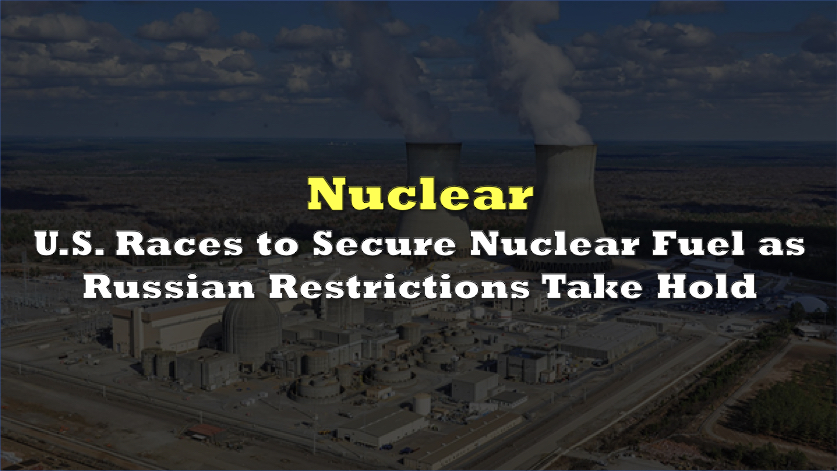As the United States aims to triple its nuclear power capacity by 2050, concerns over supply chain vulnerabilities have pushed policymakers and industry leaders to confront the nation’s heavy reliance on Russian-enriched uranium. Russia, which controls nearly 44% of global uranium enrichment capacity, has long been a dominant supplier of nuclear fuel to U.S. utilities.
However, mounting geopolitical tensions and restrictions on imports of Russian nuclear materials are spurring a domestic effort to rebuild America’s enrichment capabilities.
Data from Centrus Energy and other sources reveal that U.S. domestic uranium enrichment capacity has plummeted since the 1980s. Once a global leader, the U.S. produced over 10 million separative work units (SWU) annually—an essential metric for measuring uranium enrichment—at its peak. By 2022, this figure had fallen to virtually zero for domestically-owned facilities. In contrast, Russia, the UK-Netherlands-Germany consortium Urenco, and France have significantly expanded their capacity during the same period.

China has also emerged as a major player, with a reported capacity of 8.9 million SWU in 2022, further complicating the competitive landscape.
This decline has left the U.S. reliant on foreign imports for 72% of its uranium enrichment needs, including 27% sourced directly from Russian state-owned nuclear company Rosatom and its subsidiary Tenex. Such dependency poses a national security risk, particularly as tensions between the U.S. and Russia continue to escalate in the wake of the war in Ukraine.
😟US scrambles to break reliance on Russian #Nuclear fuel🇺🇸⚛️⛏️🏭🧑🏭 The race to boost the domestic enriched #Uranium supply chain comes amid US & Russian bans and a #NuclearEnergy revival to meet surging 24/7 power demand for #AI data centers⚛️⚡️🔌💻🤖🤠🐂 https://t.co/7mkNwTNdPy
— John Quakes (@quakes99) December 1, 2024
Domestic Enrichment
In response to Russia’s announcement last month restricting uranium exports to the U.S., the Biden administration has accelerated efforts to revitalize the domestic nuclear fuel supply chain. Washington has earmarked $3.4 billion in federal funding to boost enrichment capabilities, with Centrus Energy leading the charge.
Centrus recently announced a $60 million investment to manufacture classified centrifuge technology at its Oak Ridge, Tennessee, facility. This technology, critical for uranium enrichment, will underpin a large-scale expansion planned at its Ohio site. Vice President of Communications Dan Leistikow emphasized the urgency of the initiative, stating, “We feel a great sense of urgency about getting started… to give ourselves a head start in anticipation of further federal funding.”
The company’s progress is contingent on securing additional federal support, as it works to ramp up production of high-assay low-enriched uranium. This advanced nuclear fuel is crucial for powering next-generation small modular reactors, a key focus of the Biden administration’s plan to triple nuclear capacity by 2050.
The private sector is also stepping up. Constellation Energy, the largest U.S. nuclear operator, announced that it has stockpiled enough fuel to sustain its 21 reactors until 2029, allowing time for domestic production to scale up. However, the company issued a stark warning: “It is critical to our national security and our energy security that we move immediately to revitalize our domestic uranium conversion and enrichment capabilities.”
Meanwhile, Holtec International has secured a $1.5 billion loan to reopen the Palisades nuclear power plant in Michigan by 2025. Constellation also plans to restart a reactor at Three Mile Island, the site of the infamous 1979 nuclear accident.
Tech giants including Microsoft, Amazon, and Google are aligning with this nuclear revival. These companies have signed power purchase agreements with SMR developers to secure reliable, low-emission energy for their data centers, underscoring the growing demand for enriched uranium.
Challenges to the Supply Chain
Despite momentum, the U.S. nuclear industry faces significant hurdles. Experts cite regulatory bottlenecks, high costs, and technological risks as key barriers. While federal subsidies provide a financial cushion, the steep upfront investments required for advanced enrichment technologies could delay progress.
Moreover, global competition remains fierce. France’s Orano and Urenco are both racing to expand their presence in the U.S. market, while China continues to build capacity at an unprecedented pace.
The stakes extend beyond economic competition. With nuclear energy accounting for about 20% of U.S. electricity generation and serving as the largest source of carbon-free power, securing a stable fuel supply is critical for achieving climate goals. The Biden administration has proposed adding 35 gigawatts of nuclear capacity by 2034, a move that would reduce reliance on fossil fuels and support growing energy demands from electrification and data-intensive industries.
However, rebuilding domestic enrichment capabilities is not merely a climate imperative—it is also a matter of national security. “The ability to produce our own nuclear fuel is fundamental to energy independence and resilience,” said Ali Zaidi, White House national climate adviser.
With bipartisan support for nuclear energy growing, the U.S. appears poised to regain some of its lost ground in uranium enrichment. Still, the timeline for large-scale production remains uncertain, and reliance on Russian imports is unlikely to disappear entirely before 2028, when current waivers allowing limited imports expire.
As Centrus Energy and other stakeholders work to rebuild the domestic supply chain, the success of these initiatives will depend on sustained federal investment, technological innovation, and industry collaboration. In the words of Leistikow, “The nuclear revival we’re seeing now hinges on having a secure, stable supply chain—and that starts here at home.”
Information for this story was found via Financial Times and the sources mentioned. The author has no securities or affiliations related to the organizations discussed. Not a recommendation to buy or sell. Always do additional research and consult a professional before purchasing a security. The author holds no licenses.









